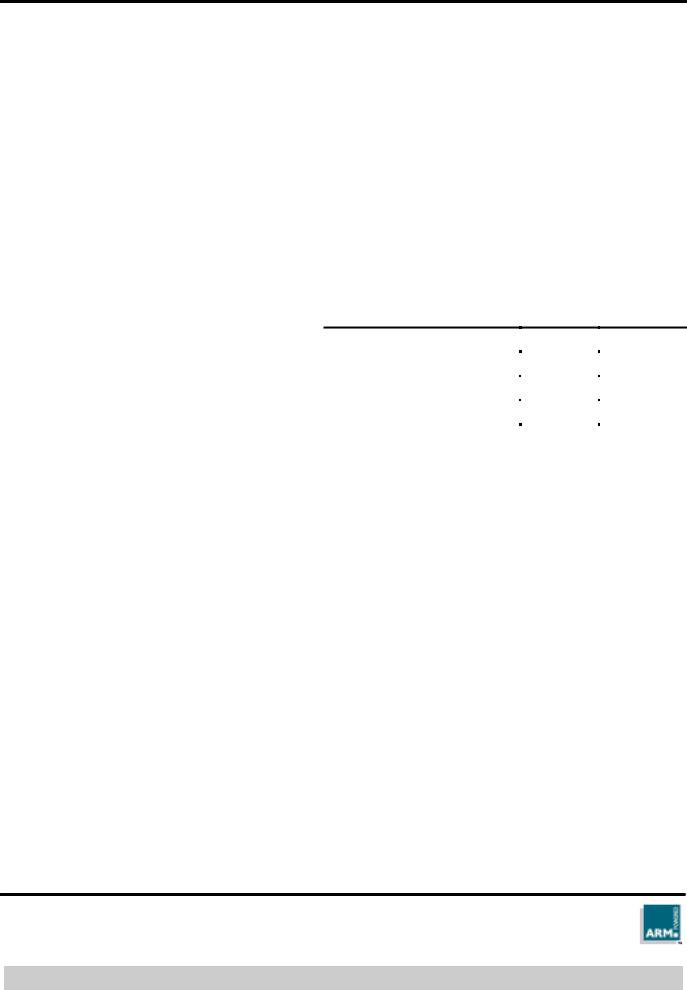
(ARM).Writing efficient C for ARM
.pdf
Register Allocation
test2
STMDB sp!,{v1,v2,lr}
LDR |
v1,[pc, #L00002c-.-8] |
LDR v2,[v1,#0]
BL f
ADD v2,a1,v2
BL g
ADD a1,a1,v2
STR a1,[v1,#0]
LDMIA sp!,{v1,v2,pc}
Note that test1 must load and store the global errs value each time it is incremented, whereas test2 stores localerrs in a register and needs only a single instruction.
8.2.3 Pointer chains
Pointer chains are frequently used to access information in structures. For example, a common code sequence is:
typedef struct { int x, y, z; } Point3;
typedef struct { Point3 *pos, *direction; } Object;
void InitPos1(Object *p)
{
p->pos->x = 0; p->pos->y = 0; p->pos->z = 0;
}
However, this code must reload p->pos for each assignment, because the compiler does not know that p->pos->x is not an alias for p->pos. A better version would cache p->pos in a local variable:
void InitPos2(Object *p)
{Point3 *pos = p->pos; pos->x = 0;
pos->y = 0; pos->z = 0;
}
Another possibility is to include the Point3 structure in the Object structure, thereby avoiding pointers completely.
Application Note 34
ARM DAI 0034A |
19 |
Open Access

Register Allocation
8.3 Live variables and spilling
As the ARM has a fixed set of registers, there is a limit to the number of variables that can be kept in registers at any one point in the program. With the recommended options, there are 14 integer registers available. For hardware floating-point, eight separate floating-point registers are available. For software floating-point, the integer registers are used to hold floating-point variables.
The ARM compilers support live-range splitting, where a variable can be allocated to different registers as well as to memory in different parts of the function. The live-range of a variable is defined as all statements between the last assignment to the variable, and the last usage of the variable before the next assignment. In this range the value of the variable is valid, thus it is alive. In between live ranges, the value of a variable is not needed: it is dead, so its register can be used for other variables, allowing the compiler to allocate more variables to registers.
The number of registers needed for register-allocatable variables is at least the number of overlapping live-ranges at each point in a function. If this exceeds the number of registers available, some variables must be stored to memory temporarily. This process is called spilling. The compiler spills the least frequently used variables first, so as to minimize the cost of spilling. Spilling of variables can be avoided by:
∙Limiting the maximum number of live variables. This is typically achieved by keeping expressions simple and small, and not using too many variables in a function. Subdividing large functions into smaller, simpler ones might also help.
∙Using register for frequently-used variables. This tells the compiler that the register variable is going to be frequently used, so it should be allocated to a register with a very high priority. However, such a variable may still be spilled in some circumstances.
|
Application Note 34 |
20 |
ARM DAI 0034A |
Open Access

Variable Types
9 Variable Types
The C compilers support the basic types char, short, int and long long (signed and unsigned), float and double. Using the most appropriate type for variables is important, as it can reduce code and/or data size and increase performance considerably.
9.1 Local variables
Where possible, it is best to avoid using char and short as local variables. For the types char and short the compiler needs to reduce the size of the local variable to 8 or 16 bits after each assignment. This is called sign-extending for signed variables and zeroextending for unsigned variables. It is implemented by shifting the register left by 24 or 16 bits, followed by a signed or unsigned shift right by the same amount, taking two instructions (zero-extension of an unsigned char takes one instruction).
These shifts can be avoided by using int and unsigned int for local variables. This is particularly important for calculations which first load data into local variables and then process the data inside the local variables. Even if data is input and output as 8- or 16-bit quantities, it is worth considering processing them as 32-bit quantities.
Note If you do this you must ensure that the results will be identical.
Consider the following three functions:
int wordinc (int a) { return a + 1;
}
short shortinc (short a) { return a + 1;
}
char charinc (char a) { return a + 1;
}
wordinc |
|
ADD |
a1,a1,#1 |
MOV |
pc,lr |
shortinc |
|
ADD |
a1,a1,#1 |
MOV |
a1,a1,LSL #16 |
MOV |
a1,a1,ASR #16 |
MOV |
pc,lr |
charinc |
|
ADD |
a1,a1,#1 |
AND |
a1,a1,#&ff |
MOV |
pc,lr |
Application Note 34
ARM DAI 0034A |
21 |
Open Access

Variable Types
9.2 Use of shorts/signed bytes on ARM
ARM processors implementing an ARM Architecture earlier than version 4 do not have the ability to load or store halfwords (shorts) or signed bytes (signed char) directly to or from memory. These operations are implemented using load/store byte operations and shifts, and may take up to four instructions. On Architecture 4 and later, these operations only take a single instruction.
Therefore, if possible, select Architecture 4 processors for applications which use shorts or signed chars heavily.
The following example illustrates the effect of using shorts and the -arch 4 option.
VARTYPE array [2000];
void varsize (void)
{int loop;
for (loop = 0; loop < 2000; loop++) array[loop] = loop;
}
This gives the following results:
Compiler options |
|
Code size |
|
ZI data size |
-DVARTYPE=int |
32 |
8000 |
||
|
|
|
||
-DVARTYPE=short -arch 3 |
44 |
4000 |
||
|
|
|
||
-DVARTYPE=short -arch 4 |
36 |
4000 |
||
|
|
|
|
|
9.3 Space occupied by global data
If your code uses C global variables, you are advised to read Application Note 36: Declaring C Global Data (ARM DAI 0036) for details of how the compilers map such variables onto memory and how this can be controlled.
|
Application Note 34 |
22 |
ARM DAI 0034A |
Open Access

Function Design
10 Function Design
In general, it is a good idea to keep functions small and simple. This enables the compiler to perform other optimizations, such as register allocation, more efficiently.
10.1 Function call overhead
Function call overhead on the ARM is small, and is often small in proportion to the work performed by the called function.
∙The minimal call-return sequence is BL ... MOV pc, lr, which is extremely fast (four cycles on StrongARM1, six cycles on ARM7).
∙The multiple load and store instructions, LDM and STM (PUSH and POP in the Thumb instruction set) reduce the cost of function entry and exit when some registers need to be saved.
Under the ARM Procedure Call Standard (APCS), up to four words of arguments can be passed to a function in registers. These arguments can be integer-compatible (char, shorts, ints and floats all take one word), or structures of up to four words (including the 2-word doubles and long longs).
If more arguments are needed, then the fifth and subsequent words are passed on the stack. This incurs the cost of storing these words in the calling function and reloading them in the called function.
Consider the following sample code:
int f1(int a, int b, int c, int d) { return a + b + c + d;
}
int g1(void)
{ return f1(1, 2, 3, 4);
}
int f2(int a, int b, int c, int d, int e, int f) { return a + b + c + d + e + f;
}
ing g2(void)
{ return f2(1, 2, 3, 4, 5, 6);
}
The fifth and sixth parameters are stored on the stack in g2, and reloaded in f2, costing two memory accesses per parameter.
Application Note 34
ARM DAI 0034A |
23 |
Open Access

Function Design
10.1.1 Minimizing parameter passing overhead
To minimize the overhead of passing parameters to functions:
∙Try to ensure that small functions take four or fewer arguments. These will not use the stack for argument passing.
∙If a function needs more than four arguments, try to ensure that it does a significant amount of work, so that the cost of passing the stacked arguments is outweighed.
∙Pass pointers to structures instead of passing the structure itself.
∙Put related arguments in a structure, and pass a pointer to the structure to functions. This will reduce the number of parameters and increase readability.
∙Minimize the number of long long parameters, as these take two argument words. This also applies to doubles if software floating-point is enabled.
∙Avoid functions with a parameter that is passed partially in a register and partially on the stack (split-argument). This is not handled efficiently by the current compilers: all register arguments are pushed on the stack.
∙Avoid functions with a variable number of parameters. Varargs functions effectively pass all their arguments on the stack.
10.1.2Using __value_in_regs
A structure can be used to return multiple return values from a function. Normally, structures are returned on the stack. However, the compiler provides the __value_in_regs specifier, which can be used to return structures of up to four words in registers. This reduces memory traffic, enables the structure to be allocated to registers, and can give considerable reduction in code size.
For example, the ARM Software Floating-Point Library uses __value_in_regs to return structures containing intermediate results, which reduces code size and increases speed significantly. Long longs and doubles are returned by default using __value_in_regs.
Consider the following example:
typedef struct { int hi; uint lo; } int64; // low word unsigned!
__value_in_regs int64 add64(int64 x, int64 y)
{ int64 res; |
|
res.lo = x.lo + y.lo; |
|
res.hi = x.hi + y.hi; |
|
if (res.lo < y.lo) res.hi++; |
// carry from low word |
return res; |
|
} |
|
void test(void)
{int64 a, b, c, sum;
a.hi = 0x00000000; a.lo = 0xF0000000; b.hi = 0x00000001; b.lo = 0x10000001; sum = add64(a, b);
c.hi = 0x00000002; c.lo = 0xFFFFFFFF; sum = add64(sum, c);
}
|
Application Note 34 |
24 |
ARM DAI 0034A |
Open Access

Function Design
add64 |
|
ADDS |
a2,a2,a4 |
ADC |
a1,a3,a1 |
MOV |
pc,lr |
test |
|
STMDB |
sp!,{lr} |
MOV |
a1,#0 |
MOV |
a2,#&f0000000 |
MOV |
a3,#1 |
MOV |
a4,#&10000001 |
BL |
add64 |
MOV |
a3,#2 |
MVN |
a4,#0 |
LDMIA |
sp!,{lr} |
B |
add64 |
By using __value_in_regs, the code size is 52 bytes (compared with 160 bytes otherwise). Note how the result from the first call to add64 is returned in r0 and r1, so these registers are already prepared for the second call to add64. The compiler can use the ADC instruction, resulting in optimal code.
__value_in_regs can also be an efficient way of interfacing C to assembler when you wish to return more than one result. You can define a structure to hold the return values and then write a C function declaration using __value_in_regs:
typedef struct { int x, y, z; } Point3;
/* this is an ARM assembler function which takes a coord in r0-r3 * and returns a transformed coordinate in r0-r3
*/
__value_in_regs Point3 TransformCoord(Point3 a);
10.2 Leaf functions
A function which does not call any other functions is known as a leaf function. In many applications, about half of all function calls made are to leaf functions. Leaf functions are compiled very efficiently on the ARM, as they often do not need to perform the usual saving and restoring of registers:
∙With armcc, if the function needs up to five registers, it will use r0−r3 and r12, and thus does not need to save/restore registers.
∙With tcc, there is no save/restore overhead if the function is simple enough to compile using just r0−r3.
When registers have to be saved, STM is the most efficient method. In a leaf function, all the relevant registers are saved by a single STMFD sp!,{reg_list,lr} on entry and a matching LDMFD sp!,{reg_list,pc} on exit (or the equivalent PUSH {reg_list,lr} and POP {reg_list,pc} instructions in Thumb code).
In general, the cost of pushing some registers on entry and popping them on exit is very small compared to the cost of the useful work done by a leaf function that is complicated enough to need more than four or five registers.
Application Note 34
ARM DAI 0034A |
25 |
Open Access

Function Design
Overall, you should expect a leaf function to carry virtually no function entry / exit overhead, and at worst, a small overhead, most likely in proportion to the useful work done by the function.
If possible, you should try to arrange for frequently-called functions to be leaf functions. The number of times a function is called can be determined by using the profiling facility (refer to the Software Development Toolkit User Guide (ARM DUI 0040) for more details).
There are several ways to ensure that a function is compiled as a leaf function:
∙Avoid calling other functions. This includes any operations which are converted to calls to the C-library (such as division, or any floating-point operation when the software floating-point library is used).
∙Use __inline for small functions which are called from it (see 10.5 Inline functions on page 28 for more details).
10.3Tail continued functions
Note This section applies only to armcc.
Note Tail continuation is disabled for all debugging options.
If a function ends with a call to another function, the call can be converted to a branch to that function. This is called tail continuation. It usually saves stackspace and a branch. This optimization can be applied to any function that calls another just before returning, if none of the parameters is the address of a local variable.
Consider, for example:
extern int func2(int);
int func1 (int a, int b)
{if (a > b)
return (func2(a - b));
else
return (func2(b - a));
}
The following code is produced:
func1
CMP a1,a2
SUBLE a1,a2,a1
SUBGT a1,a1,a2
B func2
Here there is no function entry or exit overhead, and the function return has disappeared entirely: func2 returns directly to func1’s caller. In this case, the basic call-return cost for the function pair has been reduced from:
BL + BL + MOV pc,lr + MOV pc,lr
to:
BL + B + |
MOV pc,lr |
which works out as a saving of 25%. Many of the other examples given in this Application Note also benefit from this optimization.
|
Application Note 34 |
26 |
ARM DAI 0034A |
Open Access

Function Design
10.4 Pure functions
Note The pure function optimization is disabled for the -g option.
Pure functions are those which return a result which depends only on their arguments. They can be thought of as mathematical functions: they always return the same result if the arguments are the same. Therefore they must not have any side-effects, where a different value could be returned, even though the parameters are the same. For example, a pure function may use the stack for local storage, and read its parameters from the stack. However, a pure function cannot read or write global state by using global variables or indirecting through pointers. To tell the compiler that a function is pure, use the special declaration keyword __pure.
Consider the following sample code:
int square(int x) { return x * x;
}
int f(int n)
{ return square(n) + square(n);
}
square |
|
MOV |
a2,a1 |
MUL |
a1,a2,a2 |
MOV |
pc,lr |
f |
|
STMDB |
sp!,{lr} |
MOV |
a3,a1 |
BL |
square |
MOV |
a4,a1 |
MOV |
a1,a3 |
BL |
square |
ADD |
a1,a4,a1 |
LDMIA |
sp!,{pc} |
If the code is modified so that square is defined as pure:
__pure int square(int x) { return x * x;
}
f
STMDB |
sp!,{lr} |
BL |
square |
MOV |
a1,a1,LSL #1 |
LDMIA |
sp!,{pc} |
Note that square is now only called once. This is because the compiler has detected that it is a common subexpression (CSE). This optimization can only be performed on pure functions as they do not have side-effects.
Pure functions can also improve the code in other ways, as they cannot have read or written any memory locations. This means, for example, that values which are allocated to memory can be safely cached in registers, instead of being written to memory before a call and reloaded afterwards.
Application Note 34
ARM DAI 0034A |
27 |
Open Access

Function Design
Another way to tell the compiler that a function is pure is to place the following pragmas around its definition:
#pragma no_side_effects
/* function definition */
#pragma side_effects
10.5 Inline functions
Note Function inlining is disabled for all debugging options.
The ARM compilers support inline functions with the keyword __inline. This results in each call to an inline function being substituted by its body, instead of a normal call. This results in faster code, but it adversely affects code size, particularly if the inline function is large and used often.
__inline int square(int x) { return x * x;
}
#include <math.h>
double length(int x, int y)
{ return sqrt(square(x) + square(y));
}
length |
|
STMDB |
sp!,{lr} |
MUL |
a3,a1,a1 |
MLA |
a1,a2,a2,a3 |
BL |
_dflt |
LDMIA |
sp!,{lr} |
B |
sqrt |
There are several advantages to using inline functions:
∙No function call overhead.
As the code is substituted directly, there is no overhead, like saving and restoring registers.
∙Lower argument evaluation overhead.
The overhead of parameter passing is generally lower, since it is not necessary to copy variables. If some of the parameters are constants, the compiler can optimize the resulting code even further.
∙More optimizations possible.
The compiler was able to combine an ADD and MUL instruction into a multiplyaccumulate (MLA) instruction.
The big disadvantage of inline functions is that the code sizes increases if the function is used in many places. This can vary significantly depending on the size of the function, and the number of places where it is used. It is for this reason that armcc and tcc do not offer a compiler option to inline functions automatically.
In general, it is wise to only inline a few critical functions. Note that when done wisely, inlining may decrease the size of the code: A call takes usually a few instructions, but the optimized version of the inlined code might translate to even less instructions. The above examples show this: a call to square takes between one and three instructions, while an inlined square always takes a single instruction.
|
Application Note 34 |
28 |
ARM DAI 0034A |
Open Access
